_________________________________________
***** SORRY about all the ads!! I hate them, and I don’t know how to remove them, while still keeping a FREE blog account. (I’m happy to make zero $ doing this) Thank you for tolerating! … On my Mac: Safari browser: two ads, Firefox: zero ads, Google Chrome: 20+ ads!! *****
_________________________________________
NOT selling anything here …. just some info for others going thru the same thing…
If you’re near Portland Oregon, you’re welcome to borrow my stuff!

Things I wish I had known prior (and the reason I wrote this page):
While I have a super-high opinion of my Ophthalmologists and the office staff, they have NO HELP for “life at home face down.”
They could only offer a pamphlet from a rental business, with a disclaimer that they can’t “recommend” the vendors. Rental businesses send these brochures to Ophthalmology offices. They are then handed to patients who ask about recovery at home.

When first researching on the Internet, I found:
Rental or Sales companies offering the equipment….
and “support groups” or blogs, sometimes with panicked people desperate to find some comfort or answers (posts with fear and alarm).
If you’re like me, you might spend too much time researching, risking getting yourself all worked up – too much anxiety or worry. Don’t do this!
Besides your home recovery, most things are out of your hands, so don’t stress! Ophthalmologists are great and really know what they’re doing.

Most likely, you’re on your own for home recovery, with no help from health insurance for buying/renting helpful items.
– Some of us have time to prepare before surgery.
– Some of us have no time at all.
– Some of us procrastinate too long!
Use my ideas, or make your own solutions!
I didn’t want to rent or buy equipment. I wanted the cheap way, spending very little for the comforts I needed.

If you’re in a city area, Massage Chairs are often easy to find on Craigslist, new and used. $50-$350. (US) Quality varies.. how thick the foam; how well built; how comfortable the seat is; how the vinyl and stitching holds up.
I found mine cheap, clean and barely used, and it worked out great. I planned to just sell it after my recovery, but decided to loan it out to others for now.
This might be a comfort investment you can sell later, getting some, most or all of your money back.
Before buying used, make sure the top section adjusts and locks to flat horizontal (most do) (2nd photo below). Check for stripped bolts/adjustment screws, etc. Everything should tighten and hold firmly.
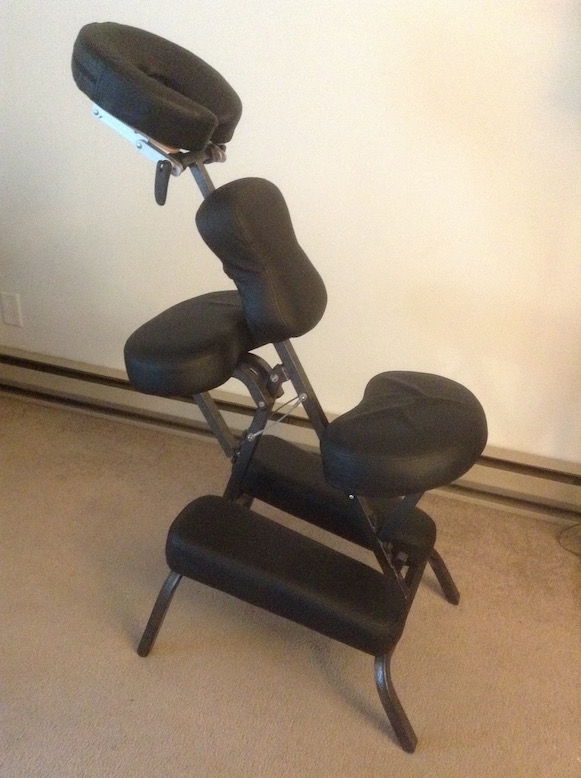
(not shown: cotton fabric to press your face into)

I took some naps in this chair, when very tired. Not bad, pretty comfy.
The Massage Chair did not turn out to be top priority for me, but I’m glad I had it, and I did use it. It was one of three places to spend the hours/days, and give the neck and back and body some variety of positions.
Actually, I spent more hours at the other two locations: in bed, and at the table.
If you’re short on money and time before surgery, I’d recommend putting planning into your BED first.

PLAN ON… your sleep schedule being a mess! Sleeping as much as possible is a good thing, passing the hours/days. I couldn’t get a full night’s sleep. If you can, that’s great! More likely, it’ll be long naps, ongoing, all hours, for days.
PLAN ON… a sore neck, and possibly a sore back. Talk to your doctor about neck pain management: likely Ibuprofen (Motrin) or Acetaminophen (Tylenol). Your doctor will tell you not to take Aspirin, because it’s a blood thinner. You might be given a prescription for “Norco” (acetaminophen with hydrocodone), or “Tylenol #3” (acetaminophen with codeine).
PLAN ON… boredom, and solutions to avoid it.

TIP … This first TIP may be the most helpful on this entire page:
Keep Moving!! … you will minimize aches and pains! Keep changing positions throughout the day. Stand, walk, stretch a lot, easy Yoga on your hands and knees (archback like a cat, and swayback), sit, lean, lay down, repeat everything … ALL while face-down. Give your neck, shoulders and back some VARIETY with different positions (angles) relative to your head. You can spend some time laying on your side (sort of), keeping your face looking down into the face pillow. Your neck will be fully extended to one side. Then turn around the other way for a while.
Don’t touch your toes while standing. Don’t get your head lower than your heart. It will feel good to stretch this way, but it adds pressure in your eye. If you feel this blood pressure in your face, don’t do it*
* or whatever your Dr says! <—- assume THIS is at the end of every paragraph here, and most websites!
Unfortunately for a few patients, you must Ignore the “Keep Moving” sentences if your Dr. instructs you otherwise. Common sense tells us: Take it easy after surgery, avoiding the physical exertion (exercise). Although I’m now a big proponent of relaxed stretching soon after surgery, certain surgeries require very strict post-op stationary positioning. Ask your Dr. about gentle stretching and how soon.

 I bought a variety of used cheap Neck Travel Pillows to try (Now I call them “Face Pillows”), and I slipped my own socks over them. You can find them used at thrift shops, cheap. Wash the removable covers, of course.
I bought a variety of used cheap Neck Travel Pillows to try (Now I call them “Face Pillows”), and I slipped my own socks over them. You can find them used at thrift shops, cheap. Wash the removable covers, of course.
My conclusion (contrary to assumptions): The firm, rigid ones are more comfortable (many hours) than the squishy soft ones. Some pillows are filled with synthetic foam, gel, memory foam… some are filled with seeds, beans, rice, various pellets, buckwheat hulls, etc.
TIP … You can add various bubble wrap pieces, packing peanuts, or many other things mentioned in the previous paragraph to make the pillow more firm (more rigid). Some pillows open up with a zipper.
TIP … Towels & washclothes! Keep lots handy.

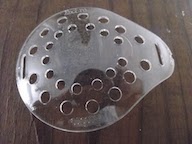


TIP … You’ll probably be given a Protective Eye Dome (rigid patch) to wear after surgery and overnight, and then to wear while sleeping for a few days (your Dr. will tell you). Problem: The outside edge of the eye patch presses a little too much against the face pillow, at the outer corner of your eye. You might feel the slight pressure on the operated eye area. I did.
Solution above: Just a slight change of shape really solved the problem. Note there’s a little more clearance on the right side. I used rubber bands for one night, which worked great. Then I remembered I have this little velcro strap. You can see how it slightly reshaped the face opening. Perfect.
TIP … You’ll be using lots of eye drops on a schedule … AND .. your Dr. may instruct you to wear your eye patch/dome while sleeping for a some nights. Tape-on-tape-off several times per day is a pain and a chore, and often leaves sticky residue on your forehead and cheek …… Solution: a simple elastic exercise sweat band. Like used for running, use a head band (sweat band) to hold the eye protector in place. No tape!! Especially helpful with your inconsistent sleep, and eye drops on a schedule.

Be careful about getting time-confused: which eye drops are every 12 hours, which are every six, maybe every four hours. Consider different alarms for different drops. ….different smart phones, or electronic kitchen timers. “Hours” can become confusing if you’re sleeping two to five hour “naps,” ongoing for many days! I was so confused one day I got 7am and 7pm mixed up.
If someone asks how they can help you, what comes to mind is, of course: transportation, food … Reminders of your eye drops schedule (medication too) can be valuable help! — and it’s a good excuse for someone who cares and wants to call you a lot, but doesn’t want to bother you. ASK THEM to please call every six hours (for example), until you get your routine worked out with confidence … If someone lives with you, even better. Give them this easy chore. It can be a VERY confusing time, these first couple days/nights following surgery.

TIP … Load up your device(s) before surgery, with movies or TV series or audio books … Set up your charging cable where you’ll be spending hours, table or bed, ideally both.
Actually, I wanted my eyes CLOSED for many awake hours, so just listening to documentary films passed a lot of the hours. Trying to read–scanning text left and right–was too much fatigue for me. I read on another web site that some doctors will discourage close-up reading for some days–moving eyes left and right hundreds of times. My Dr. didn’t advise against, but it was one of those questions we didn’t get to.
This is another favor if someone tech-savvy asks how they can help (especially if you have immediate surgery with no chance to preplan anything): Maybe someone can load up your iPad, or bring over a borrowed tablet computer or a non-active smart phone loaded with movies or a tv series or documentaries, or audio books… or lectures, or a class to learn something… language study?


Primarily for the bed, I made this hard foam piece only as a Prototype. I intended to just experiment and then make a better one, something more solid, but this prototype turned out perfect and stable enough for sleeping and watching movies in bed. I used it a lot for my entire recovery.
This is typical hard, high-density packing foam used inside a shipping box (probably from a flat screen TV box). I found it in the recycling bin outside, and easily cut pieces with a hack saw. I was looking for the older white styrofoam to experiment, but I found this first: black rigid foam. Much better. Most of this was already pieces glued together. I glued only two spots to make this shape.
I kept a couple other random foam pieces which came in handy for the table:
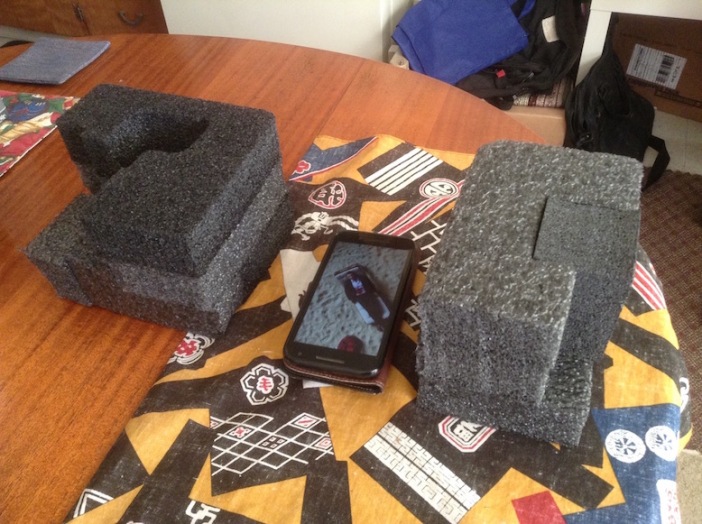
So, instead of buying or renting THIS for the table:
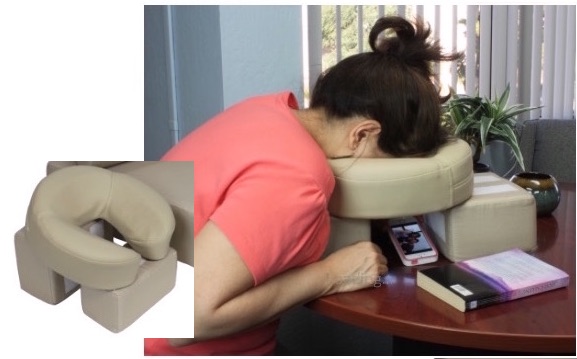 (Picky side note: I don’t think this is much of a “realistic” photo at all (same for the bed photo down the page). It’s simply a model posing for a few moments for rental/sales purposes. No one is going to press their face into sweaty vinyl for hours, when a fabric surface–cotton or cotton blend–is tolerable and comfortable. Also, this large book, possibly conflicting with Dr’s advice, cannot fit where the phone is placed. Also, like the rest of us, she’d be in pajamas or sweats or a robe).
(Picky side note: I don’t think this is much of a “realistic” photo at all (same for the bed photo down the page). It’s simply a model posing for a few moments for rental/sales purposes. No one is going to press their face into sweaty vinyl for hours, when a fabric surface–cotton or cotton blend–is tolerable and comfortable. Also, this large book, possibly conflicting with Dr’s advice, cannot fit where the phone is placed. Also, like the rest of us, she’d be in pajamas or sweats or a robe).
I tried this:

THIS was best! ….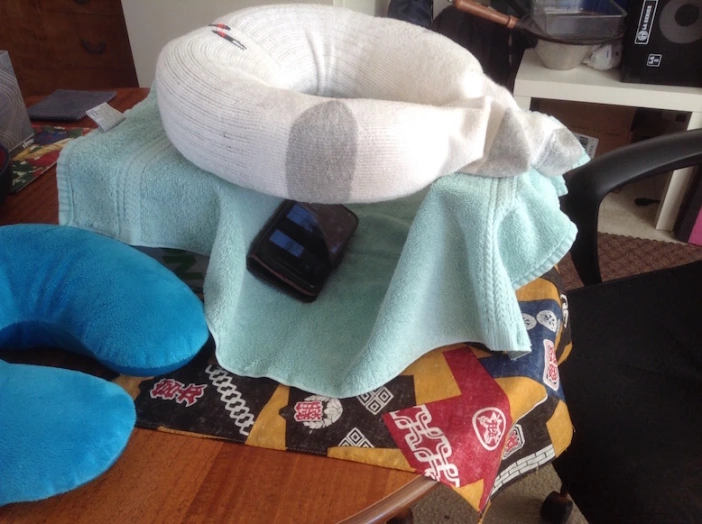
These random boxes were a good size: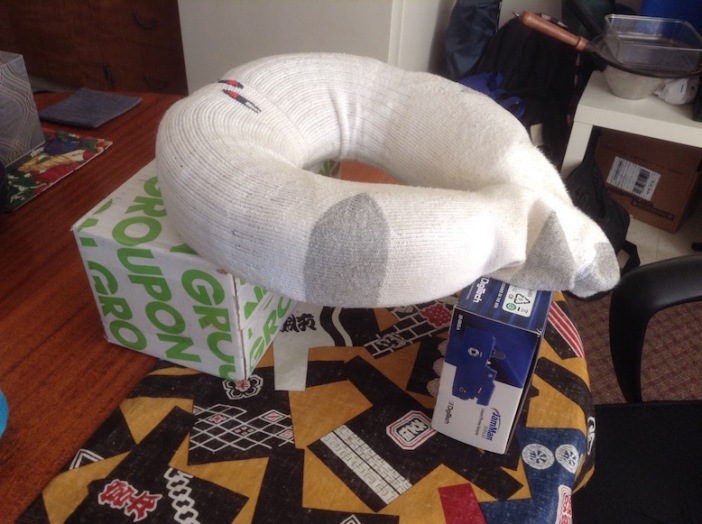
This is not actually a Neck Travel Pillow. It’s the Face Cradle (with velcro on the underside) pulled off of the Massage Chair. It’s vinyl covered foam, much more rigid than the softer pillows. I used it more than all the other face pillows.
Simple goals for the table: Comfort bending forward from a chair; a good air space for breathing; and good position/distance for watching movies on smartphone or tablet. (in bed too)

My desktop iMac facing up … daily email, plus a little internet. Not shown, but I used the rigid black foam block (next photo) to rest my forehead, at the edge of this table, placed right next to the mouse.
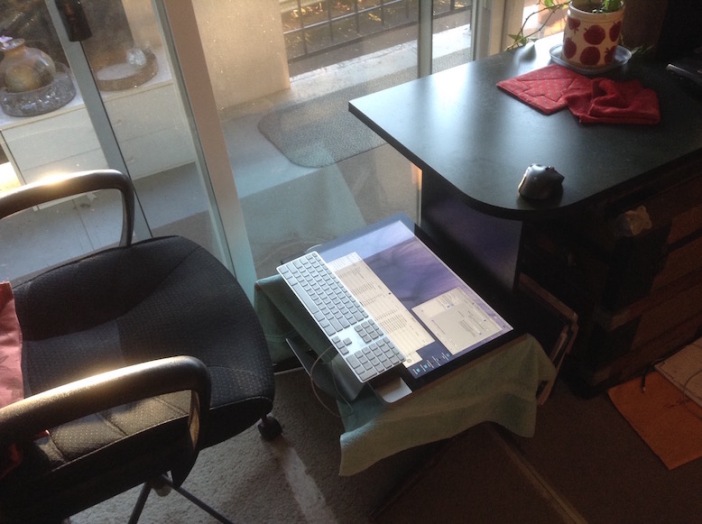
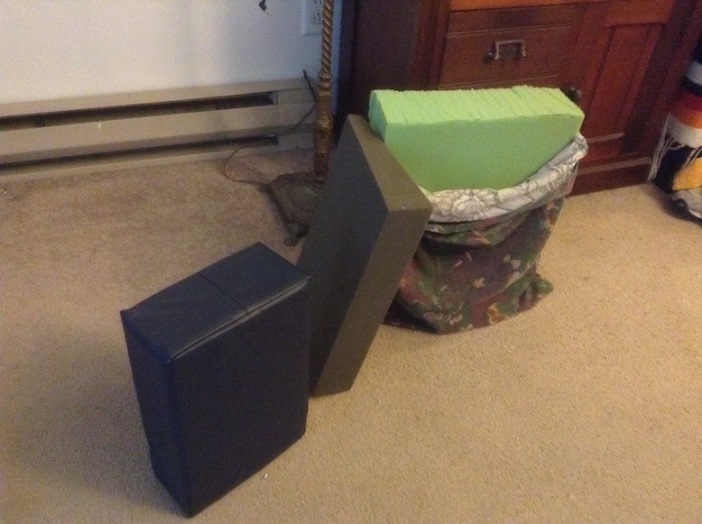
A friend loaned me these three foam pieces. Very useful. For travel in the car, coming home from surgery, the large foam (green) was adequate but could have been more firm, resting against the forehead or chin, keeping face down during the ride. Same for the next day follow-up appt. at the doctor’s office. You’ll likely prefer the back seat, with the front seat tilted forward.
Alternative for car travel (I never tried it, but it’ll work): Get any strong box approx. 14″ (lap to chin, seated) x 12″ x 5″ (like the black foam block above). Put a small towel or a couple washcloths over the top edge, and place your forehead or chin there, keeping face down for the ride. If you need more height, put a rolled up towel or something under the box. Most autos have a lengthy seat belt which will stretch forward a lot. (P.S. Don’t be the driver! 🙂 )
TIP … Dress loosely and comfortably! .. surgery day and days following. (Sweats and socks, loose shoes or slippers). DON’T feel a need to dress for the quick follow-up, day after surgery. No one cares! Go in sweats or super-lazy comfy clothes, with hair and face a mess. You won’t be making eye contact with people, and you’ll be face down… A quick exam with your surgeon, then right back home.
TIP … Wash your hair and shower in the morning, before surgery. You’ll probably be told not to shower before your follow-up the next day. Then, shower but keep water away from your operated eye for a few days (*whatever your Dr. says)

Bed
Instead of renting or buying this:
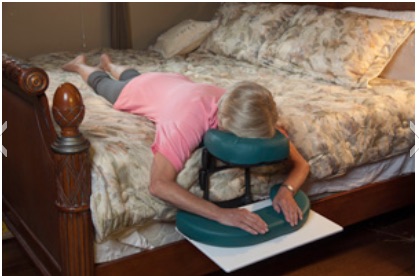
I made this arrangement… (a different kind of box, or an ottoman or coffee table might work well too):
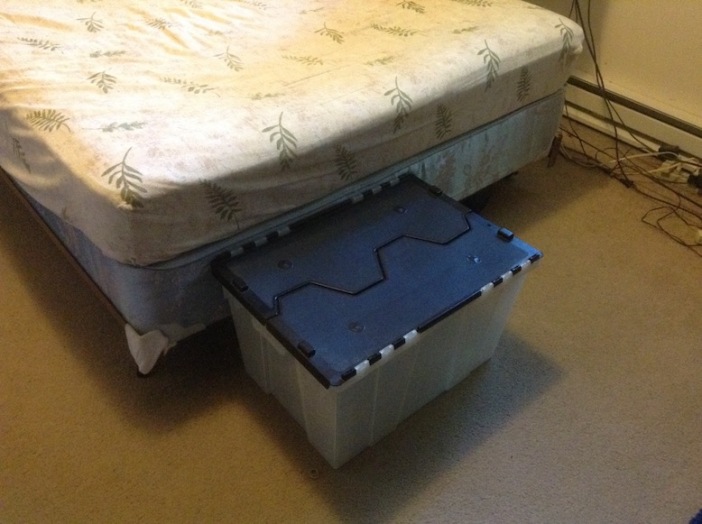
Note the box height, approx. to the bottom of the mattress. Think of the box as a “shelf” where you’ll rest your arms. I used a folded thick flannel sheet for a comfortable surface for arms (fingers/hands hanging over the front edge):

Smart phone placed down inside the green towel. …… Keeping arms forward and down of the “shelf” (box) allows your arms/shoulders to support part of the weight of your head. You’ll see. Experiment, and find the most comfortable position for hours.

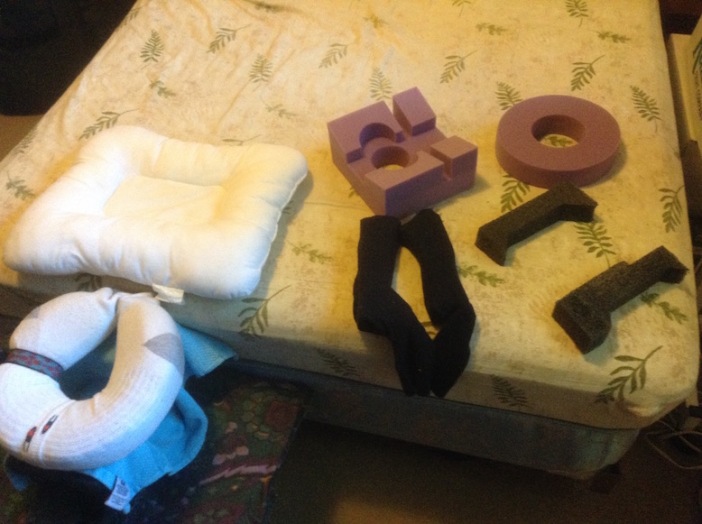
The purple foam pieces (too soft) were given to me at surgery. Better than nothing, I suppose. I had no use for them.
The black socks have hard foam pieces inside, to lift a 2nd face pillow, creating an air passage. I’m glad I had TWO options to switch between, on the same bed:
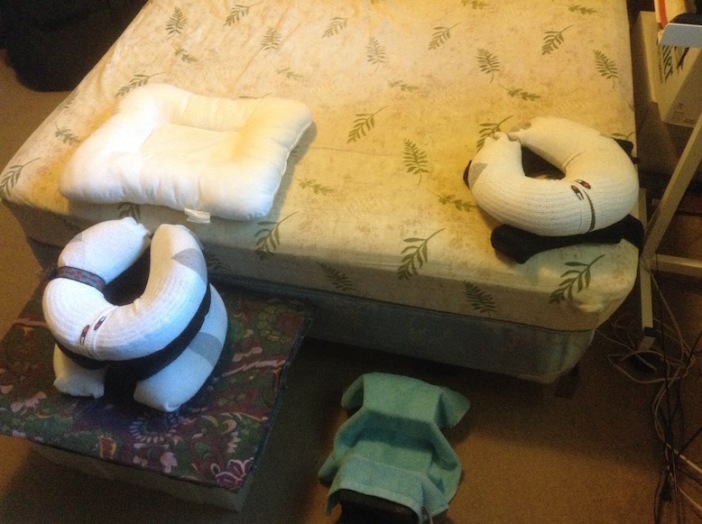
Note the three stacked face pillows. This was my softer but less stable option. Air flow not as good, but acceptable and comfy. I had my 5″ phone at the bottom, to watch (listen to) movies.
If there’s a risk you’ll roll over in your sleep, use your face pillow off the edge of the bed. You’ll definitely wake up if your head ever leaves this position.
While laying face down, putting your arms/hands at your sides (hands back toward your feet, next photo) can be very comfortable IF your head is fully supported and in a comfortable position. The entire weight of your head will be into the face pillow.

This “wedge” equipment might be a great way to go, perhaps sleeping on the floor next to the bed, or in the living room. I have no experience: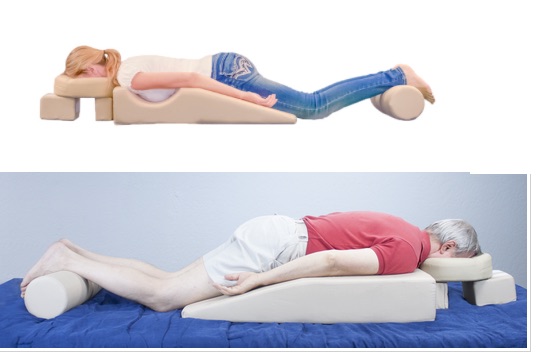
The “bolster” at your feet is a good thing. Improvise if you don’t have one. I made the same shape with a rolled up thin blanket with rubber bands, stuffed inside a pillow case… Or a rolled up exercise mat.

Rentals:
A lot of the rental companies show people playing card games, or watching TV with the special mirror. Certainly these products are designed for their purpose, and shipped to your door (very quickly, if you want to pay), and convenient. Maybe go with this option if spending the money is not an issue, or if you run out of time before surgery to prepare.
I noticed the rental companies DON’T emphasize how well they clean and sterilize their products!
I noticed many rental companies photos show people with a face pressed into vinyl ! – NOT what you want, as you’ll agree after trying for some minutes. Think cotton, or towel material (terry cloth) … some might recommend fleece.
mcfeetech.com
gotyourback.com/Vitrectomy-Surgery-Recovery-equipment-Rentals.aspx
facedownsolutions.com/comfortsolutions/
healcorrectly.com
There’s others ….. google-search “vitrectomy recovery” or “eye surgery recovery”

This double/triple strength cardboard looks pretty easy to make …. Had I not made my black foam prototype, I might have used strong boxes to make something like this:

If you’re really in trouble …. Emergency surgery with no warning … home from surgery with nothing, and absolutely no preparation….. Try to make (or get someone to help you make) a “face box” like this (I’d cut a more oval shape for eyes), and pad the top with some small towels or several washcloths. I’d get two Flat Rate Postal boxes, tightly fit one inside the other, by cutting some edges of the inner boxes so it’ll fit… then tape it for strength. Probably most shoe boxes and Kleenex tissue boxes are not going to be strong enough. Maybe one shoebox jammed inside another..
Maybe modify a strong avocado or tomato box from your grocery store.
At least: get a large bath towel, roll it up and make a horseshoe shape, and try it on your bed.
Make a breathing passage a priority, of course.

TIP … Someone told me to absolutely get the “Total Pillow” (google it) …. I didn’t have time to check it out. Maybe it’s terrific.. perhaps as a face pillow on top of the box above.


TIP … Put a clock or clock radio on the floor next to your bed, tilted upward, maybe leaning against the wall… easy to glance at.
Keep handy things next to you in bed: water bottle, kleenex, pen and pad, phone, alarm/timer (for your eye drops schedule), charging cables, etc.
TIP … Put towels, blanket, clothes you’ll be wearing down closer to the floor (sweats, pajamas, etc). Same with anything in the bathroom or kitchen, items usually up high, putting somewhere lower may help.
TIP … Refrigerator items on lower shelves may be helpful. You CAN do things in the kitchen (helps with boredom): preparing food, cleaning up, but your neck will get sore after a lot of standing face-down. Also, I was happy to have a few drinking straws handy… coffee, soup, etc. Foods that don’t need a lot of chewing might be easier. It’s not a horrible thing to briefly lift your head to chew and swallow, but, of course, keeping face down as much as you can is best. You’ll do fine!
I hope this page is helpful for you, to make the best of a no-fun situation!
tsts22 (at.. ) yahoo ( .dot) com … or post here.
Thanks for visiting, and Very Best Wishes with your surgery and recovery!
and THANKS!! so much, for all the nice words and tips! Please add more tips below.
If comments are not showing, Click on the the word “Comments” below…
